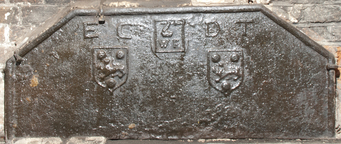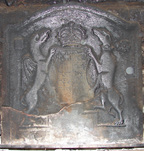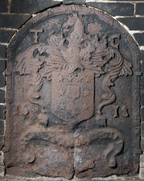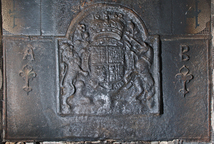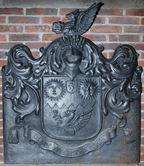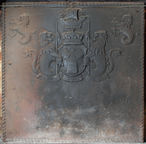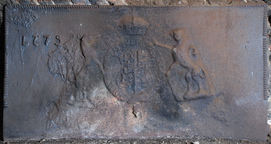-
1077
Description: Canted rectangle; astragal edging (top and sides); symmetrically arranged, initials separated by overpressed, fillet edged stamp bearing letters WF surmounted by a bent arm holding a battleaxe issuing from a chapeau; beneath are two shields bearing the arms of Fowle.
Notes: The shield and crest stamps relate to William Fowle (1568-1634) and are those used on iron grave slabs in Wadhurst and Frant churches and in Maidstone museum, as well as on other firebacks. The initials have not been identified. Another casting with the same set of initials, but in a slightly different arrangement, has been noted (no. 68), and Christy (1908 p.386) reported on another with slots for two firedogs.
Inscription: EC DT / WF
Arms: William Fowle, of Frant and Wadhurst
- Decoration tags:
- rectangular with canted top corners (shape)
- astragal (edging)
- carved stamps
- individual letters
- heraldic
- armorial
- text
Manufactured: in the early- to mid-17th century probably at Riverhall Furnace, Wadhurst in the Weald area of England.
Current location: in private hands, Minster-on-Sea, Kent, England.
- Attached to series:
- Fowle series
-
1296
Description: Low arched rectangular shape; broad rebated fillet edging; stylised Tudor royal shield, crown and supporters (dragon and greyhound); Tudor rose in top left corner; portcullis in top right corner.
Notes: Pastiche 'Tudor' design by George Shaw of Saddleworth, Lancashire, c.1850, possibly intended to be passed off as genuine Tudor. Another casting is at Hever Castle, Kent. Firebacks with the same armorial design within a different, arched edging are also known.
Copies of this fireback are known.
Arms: Tudor royal
- Decoration tags:
- rectangular with round arch (shape)
- fillet (edging)
- carved pattern panels
- heraldic
- armorial
- royal
Manufactured: in the mid-19th century possibly in the Lancashire area of England.
Current location: Mottistone Manor, Brighstone, Isle of Wight, England.
Museum number: NT/MOE/M/2 (part of the National Trust museum group)
- Attached to series:
- George Shaw series
- Tudor royal armorial firebacks
-
954
Description: Arched shape; patterned astragal edging; central shield with helm, crest and mantling above, and motto scroll below; initials either side of crest; date split by shield.
Notes: The arms are those of Chamberlayne: gules, an inescutcheon within an orle of mullets argent; the crest: out of a ducal coronet the head of an ass (the tinctures vary according to the branch of the family); the initials are reputed to be those of Thomas Chamberlayne; the date appears to have been hand inscribed. The style of the carving is the same as on two other firebacks in the same county.
Inscription: T C / 16 18 / [motto unreadable]
Arms: Chamberlayne
- Decoration tags:
- rounded arched (shape)
- astragal (edging)
- whole carved pattern
- individual letters
- individual numbers
- armorial
- text
Manufactured: in 1618 possibly in the Herefordshire area of England.
Current location: Hellens Manor, Much Marcle, Herefordshire, England.
- Attached to series:
- Personal armorial firebacks
- Herefordshire armorial series
-
502
Description: Arched rectangular shape; embattled cavetto-moulded edging; shield, garter, supporters and crown of James I of England; a branch sprouting a rose and leaf to the left of the crown, a branch sprouting a thistle and leaf to the right; initials at top, split by crown; date below shield.
Notes: Similar in style to the 1619 series, this plate has larger rose and thistle plant stamps and was probably designed by the same pattern-maker
Copies of this fireback are known.
Inscription: I R / 16 21
Arms: English Stuart royal - James I
- Decoration tags:
- rectangular with round arch (shape)
- embattled cavetto (edging)
- whole carved pattern
- armorial
- royal
Manufactured: in 1621 in England.
Current location: Newick Park Hotel, Newick, East Sussex, England.
-
1144
Description: Composite; arched rectangular shaped, armorial fireback, cavetto edging, with Stuart Royal arms, garter, supporters, crown and motto, and 1662 date above crown; this overlies a rectangular plate with fillet edging; top centre in the space each side of the central shield, an initial letter - A to left, B to right - each above a fleur-de-lys, its stem terminating in a small buckle.
Notes: Several firebacks have incorporated the same Stuart royal shield, which probably originally dated to 1619, but with the date altered. A similar fireback, but without the initials and fleurs-de-lys, dated 1661, and reputed to have come from the Totsey, the old guildhall at the market cross in Gloucester, is illustrated in Ames, 1980, 23; possibly the same fireback was reported by the late David Bick to be at The Grange, Minsterworth, Gloucestershire (demolished in the late 1960s).
Inscription: 16 62 / [Garter motto (illeg.)] / A B
Arms: English Stuart royal
- Decoration tags:
- rectangular with round arch (shape)
- fillet (edging)
- carved stamps
- carved pattern panels
- composite
- individual letters
- heraldic
- armorial
- royal
- text
Manufactured: in 1662 possibly in the Forest of Dean area of England.
Current location: in private hands, Norton, Wiltshire, England.
Citation: Ames, A., 1980, Collecting Cast Iron (Ashbourne, Moorland Publishing).
Citation: Badeni, J., 22 Sep 1983, 'Whose Fireback?' [letter], Country Life, 174, 4492, p. 772.
-
1237
Description: Low-arched rectangular shape; cavetto-moulded edging (top and sides); top centre, shield, crest and motto of William Wood (1806-88), Bishop of Glasgow and Galloway.
Notes: The blazon: Per chevron Argent and Or, a chevron counter-embattled between three mullets gules; crest: a talbot's head erased Or; motto: Semper Vigilans - Always Vigilant.
Inscription: SEMPER VIGILANS
Arms: William Wilson, Bishop of Glasgow and Galloway
- Decoration tags:
- rectangular with round arch (shape)
- cavetto (edging)
- whole carved pattern
- heraldic
- armorial
- text
Manufactured: in the mid- to late-19th century in Scotland.
Current location: Norfolk Antique and Reclamation Centre, Woolseys Farm, Salhouse Road, Panxworth, Norfolk, England.
- Attached to series:
- Personal armorial firebacks
-
506
Description: Plain rectangular shield with sloping edges; shield helm and crest of Sir Weetman Pearson Bt.: Per fess indented gules and or, between two suns in splendour in chief an escutcheon bearing a baronet's badge, and a demi-gryphon couped wings elevated and addorsed in base all counterchanged; crest: in front of a demi-gryphon as in the arms, holding between the claws a mill-stone proper, thereon a mill-rind sable, a sun in splendour.
Notes: Sir Weetman Pearson, later Viscount Cowdray, was created Baronet in 1894 and Baron in 1910, the fireback thus dates from the period 1894-1910. The motto - Do it with thy might - is from Ecclesiates 9: 10.
Copies of this fireback are known.
Inscription: DO IT WITH THY MIGHT
Arms: Sir Weetman Pearson Bt
- Decoration tags:
- complex individual (shape)
- none (edging)
- whole carved pattern
- armorial
- text
Manufactured: in the late-19th century in England.
Current location: Parham House, Parham, West Sussex, England.
- Attached to series:
- Personal armorial firebacks
-
507
Description: Low arched rectangle with stepped shoulders; cavetto moulded edging; Stuart royal shield with lion and unicorn supporters, garter and crown.
Notes: The pattern was probably carved in high relief, but the depth of casting sand may have been insufficient for all the detail to be revealed. At least one horizontal plank line is visible.
Copies of this fireback are known.
Arms: English Stuart royal
- Decoration tags:
- rectangular with round arch (shape)
- rebated fillet (edging)
- whole carved pattern
- planklines
- armorial
- royal
Manufactured: in the late-17th to early-18th century in England.
Current location: Parham House, Parham, West Sussex, England.
- Attached to series:
- Stuart royal armorial firebacks
-
907
Description: Rectangular; simulated twisted rope edging; top centre, shield, baron's coronet, supporters and crest; in each top corner, heraldic badge - a Sea Lion holding an anchor.
Notes: The arms are of Sir Hudson Ewbanke Kearley, Bt., 1st Baron Devonport (1856-1934); created 1910, he was elevated to Viscount in 1917, thus the fireback would have been cast between 1910 and 1917. Blazon: Azure in chief two Mitres Argent garnished Or and in base a Square Tower of the second, a baronet's badge in chief; Supporters: On either side a Sea Lion Argent crined finned and tufted Or each gorged with a Collar Gules charged with three Roses of the second and each supporting a Spear erect proper; Crest: An Ancient Ship Or the Mainsail Azure charged with a Sea Lion of the first; Motto: Fit Via Vi (The way is made through strength). A version with the same arms and badges has an arched rectangular shape and plain edging.
Inscription: FIT VIA VI
Arms: Hudson Ewbanke Kearley, 1st Baron Devonport (later 1st Viscount)
- Decoration tags:
- rectangular (shape)
- simulated rope (edging)
- carved stamps
- heraldic
- armorial
Manufactured: in the early-20th century in England.
Current location: in private hands, Penhurst, East Sussex, England.
- Attached to series:
- Personal armorial firebacks
- Devonport arms series
-
515
Description: Rectangular; rope edging (top & sides); in centre, Tudor shield, garter, crown and supporters (greyhound and lion); date top left.
Notes: The armorial achievement is seen on other firebacks and was formed from four separate stamps (one example has the shield and garter inverted); the supporters are consistent with the date; the style of the numerals is uncharacteristic of the period. The same date in identical form is on a similar fireback at Groombridge Place, Speldhurst, Kent.
Inscription: 1579 / HONE SOVT qVEY MAL Y PENSE
Arms: Tudor royal
- Decoration tags:
- rectangular (shape)
- rope (edging)
- carved stamps
- date stamp
- armorial
- royal
- text
Manufactured: in 1579 in the Weald area of England.
Current location: Penshurst Place, Penshurst, Kent, England.
- Attached to series:
- Pounsley series
- Tudor royal armorial firebacks
- Tudor redated series
